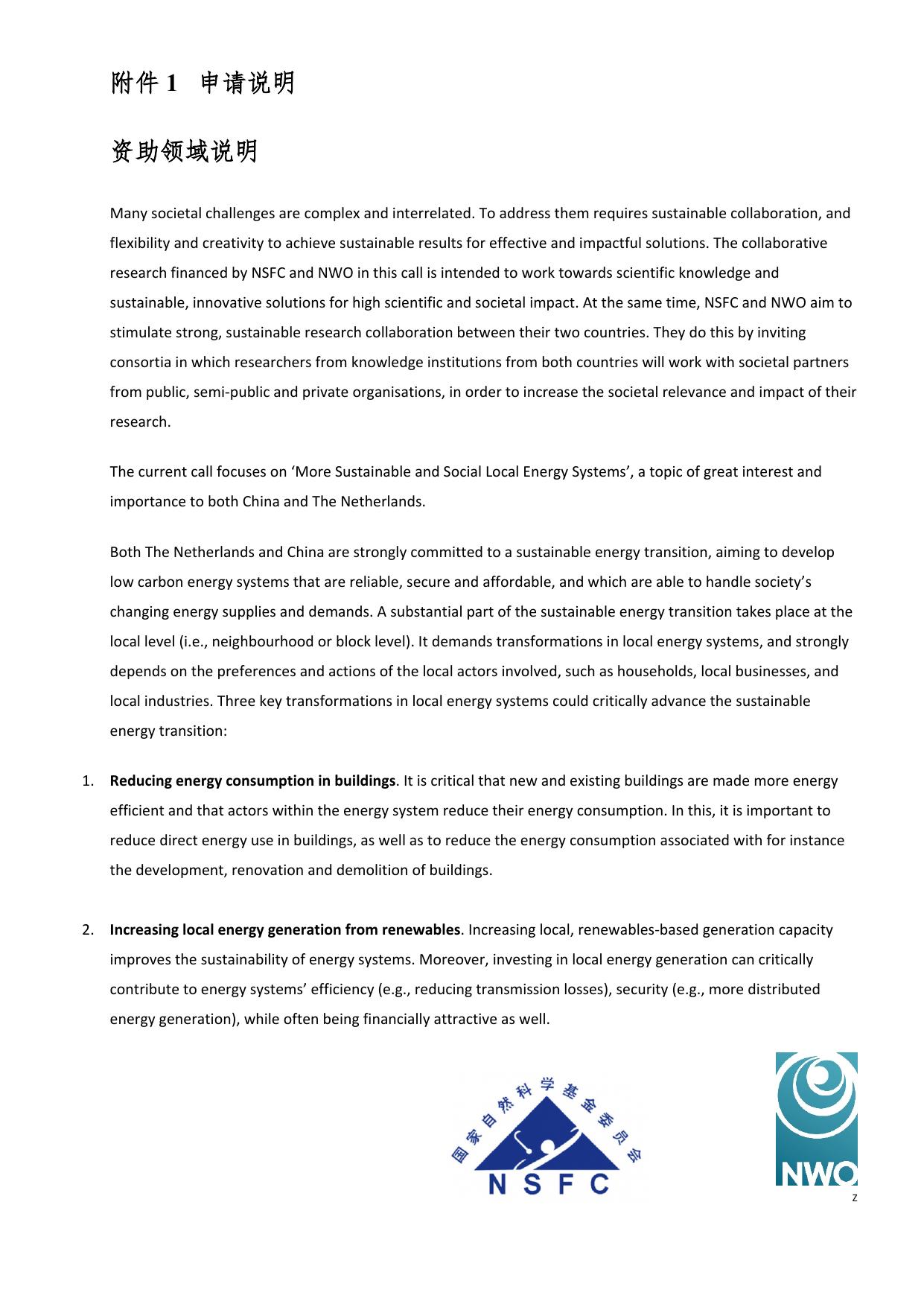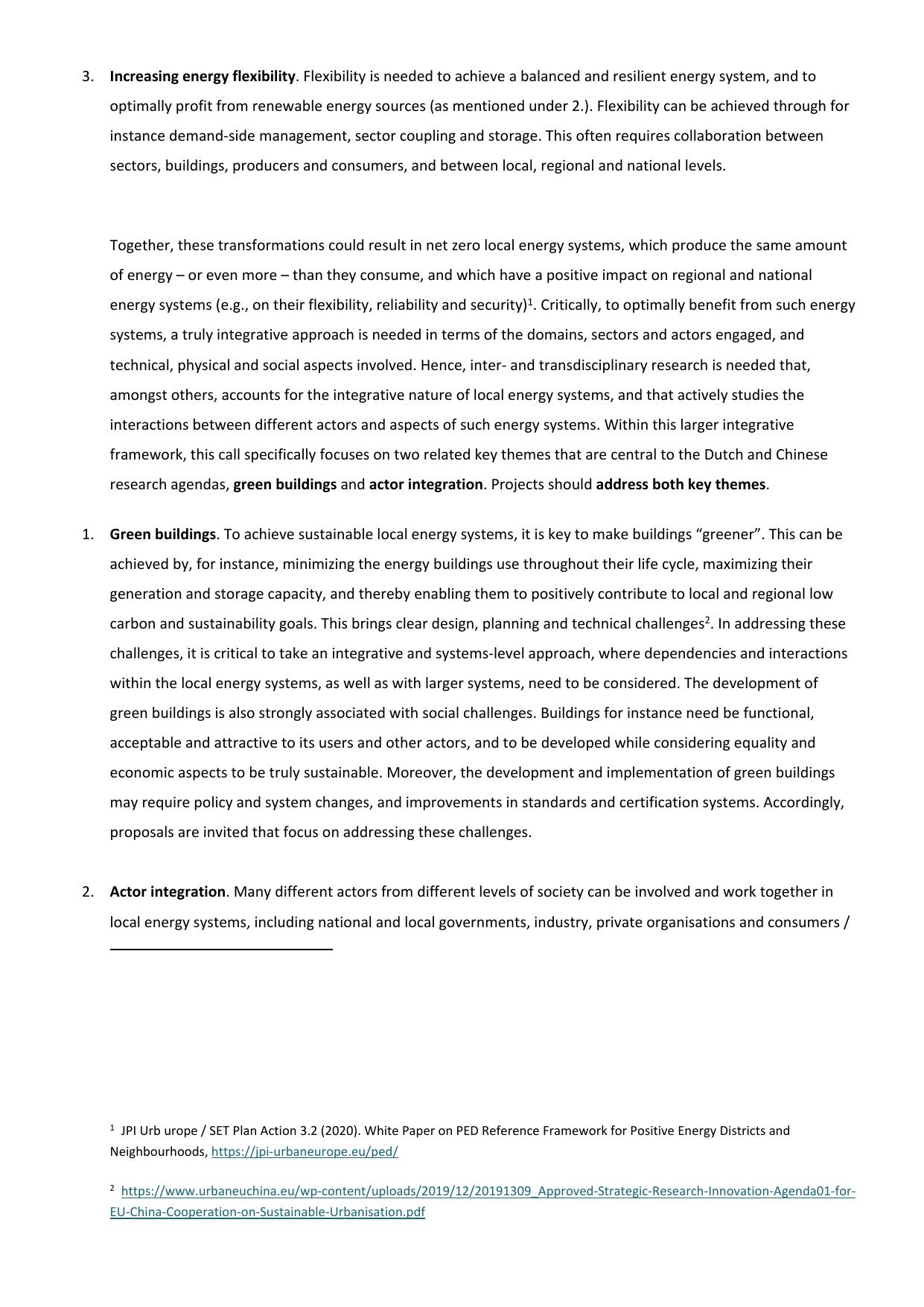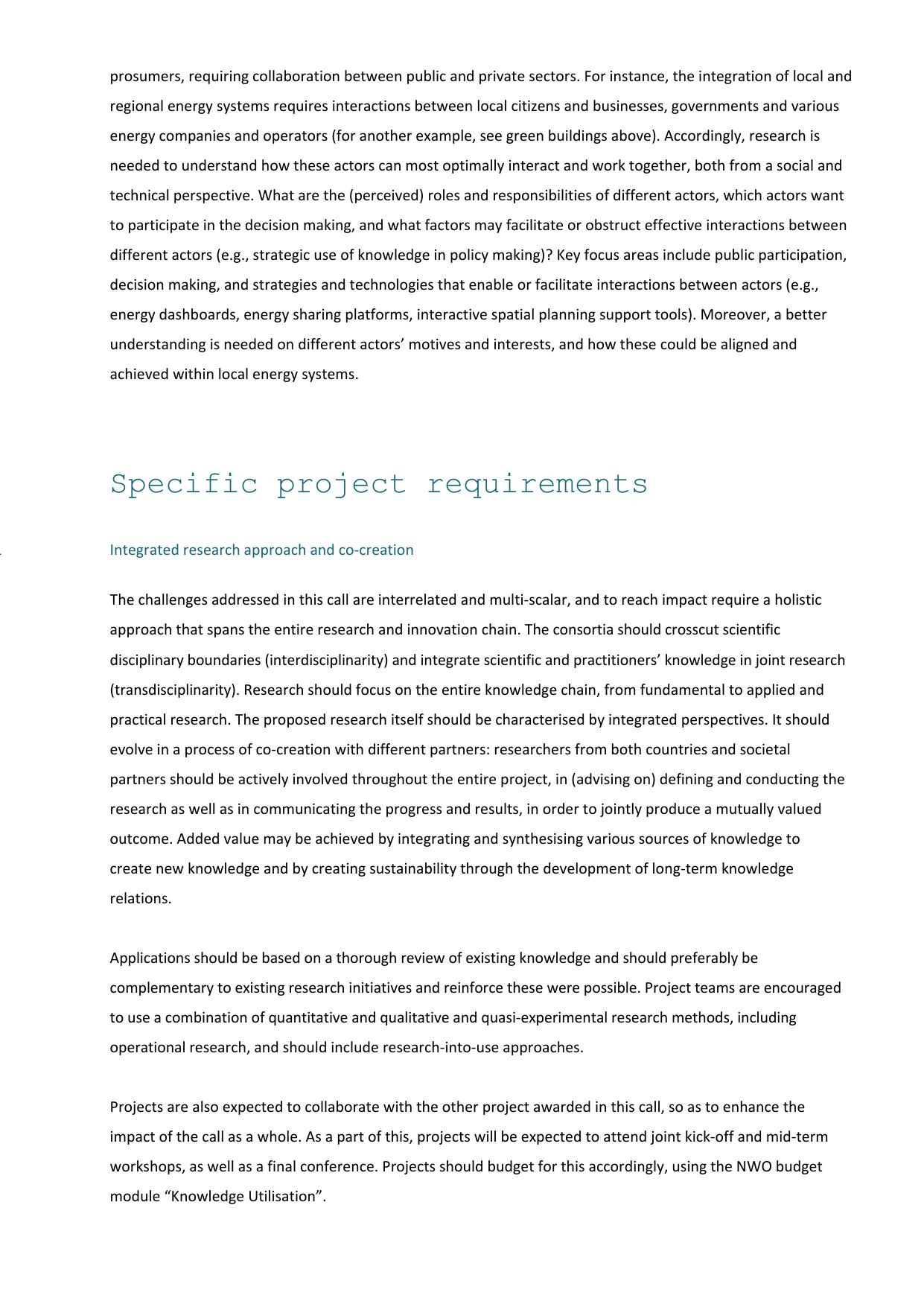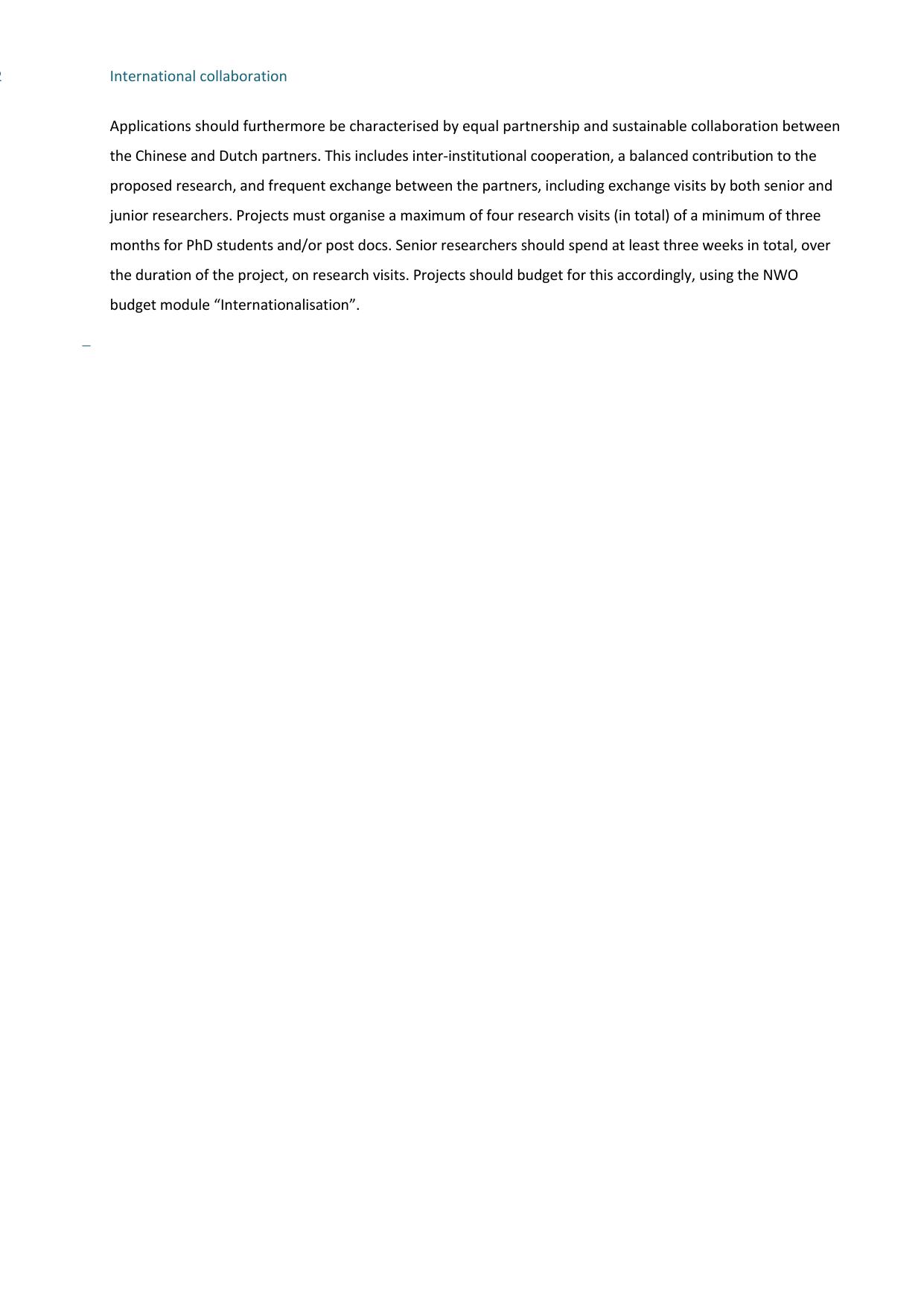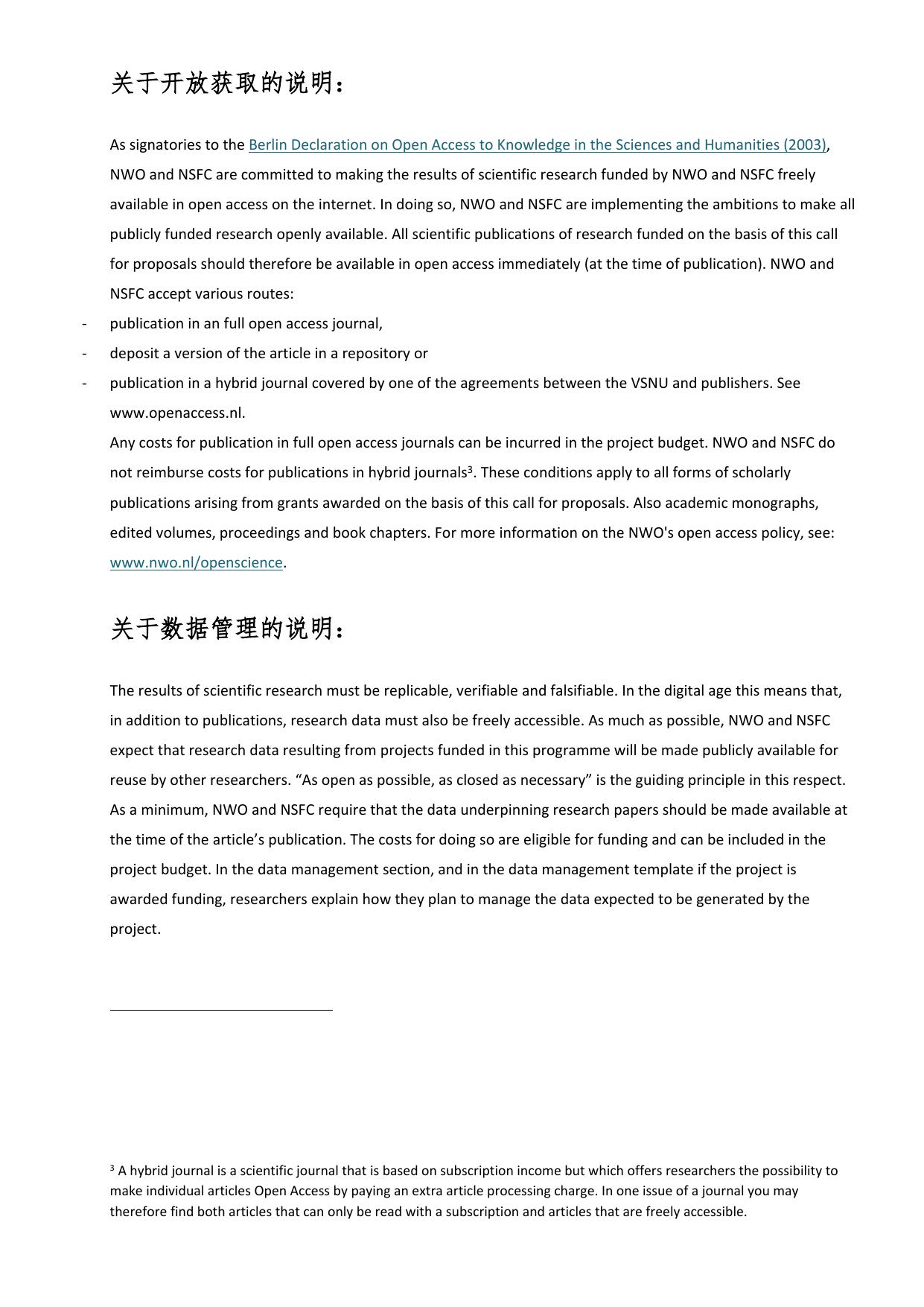长安大学公路学院1. 申请说明.docx
Application form Cooperation China-The Netherlands Call 2020 附件 2 英文申请书模板 How to fill out this application form The instructions for filling in this form are indicated in the icons or in the fold-out titles with explanatory notes. This application form consists of six sections. Each section contains further clarification and notes on how to fill out the related questions. When writing your proposal, please be specific, and provide only information that applies to the proposal and its objectives and take into account that it will be assessed by both expert reviewers as well as the International Advisory Committee with a broad range of expertise. Please adhere to the following guidelines when filling out this application form: Use the Calibri font at font size 9.5 and do not change the margins (2,5 cm, all directions); You may use subheadings; Instructions regarding attachments The following compulsory attachments (budget form, CV’s, letters of commitment, and, (if applicable) letter(s) of guarantee) should be included as annex in the proposal. Appendices with supplementary information are not allowed, nor are annexes other than the ones specified here: CVs: For each Principal Investigator, co-applicant, and collaboration partner, a CV of max. 1 A4 should be provided. Only the CVs of the Principal Investigators, co-applicants and collaboration partners mentioned in 1b or 1d should be included. CVs of project staff who are not a Principal Investigator, official coapplicant or collaboration partner should not be included. Letter(s) of commitment: each consortium organisation (i.e. the institutions of the Principal Investigators, the co-applicants and the collaboration partners) should provide a letter in which the institution or organisation confirms that they agree to the conditions required for the execution of the project. The letter must be signed by the Dean of the faculty or director of the organisation and be printed on the letterhead of the institution or organisation. A format can be found in Annex 6.1 of the Call for Proposals. If the institution or organisation is providing co-funding as well, the numeric amount should be specified in the Letter of Commitment. Draft consortium agreement: detailing agreements regarding rights (such as copyright, publications, intellectual property etc. of products or other developments in the project), knowledge utilisation, as well as affairs such as payments, progress- and final reports, and confidentiality. The agreement furthermore details agreements on governance of the consortium (to the extent that it gives sufficient guarantee for effective collaboration), finances, and if applicable, basic knowledge to be contributed, liability, disputes, and information sharing within the consortium. The agreement has to be drafted in a spirit of equity. If the proposal is awarded, the consortium will be asked for a final, signed version prior to the start of the project. A format can be found on the financing page of this call. Letter(s) of guarantee: For each co-financing partner a letter of guarantee regarding the co-funding should be submitted. In a letter of guarantee, the co-financing partner expresses their support for the project and confirms the co-funding pledge and the agreements with respect to intellectual property and publications as stated in the application and in the draft consortium agreement. Letters of guarantee are 1/23 Cooperation China-The Netherlands, Call 2020 – Application form unconditional and do not contain opt-out clauses. The NWO budget must be uploaded as a separate Excel document in ISAAC. Submission Please submit the full proposal including the compulsory annexes to NWO (PDF format is required!) via the online application system ISAAC, which can be accessed via the NWO website. The proposal must be submitted through the account of the Dutch Principal Investigator. For any technical questions regarding submission, please contact the ISAAC helpdesk (isaac.helpdesk@nwo.nl). PLEASE NOTE: full proposals must also be submitted by the Chinese Principal Investigator to NSFC, who may have additional requirements for eligibility. Applications not submitted before the deadline to both NWO and NSFC will not be admitted to the assessment procedure. Deadline for submitting the full proposal: 11 May 2021, 14:00:00 CET (to NWO) / 12 May 2021, 16:00 CST (to NSFC). 1. Registration Form (basic details) 1a. Title of research proposal Insert project title here 1b. Details of the two Principal Investigators (PI): Dutch PI Title: First name: Initials: Prefix: Surname: Male / female: Institution: Address for correspondence: Telephone: E-mail: Website (optional): Chinese PI Title: 2/23 Cooperation China-The Netherlands, Call 2020 – Application form First name: Initials: Prefix: Surname: Male / female: Institution: Address for correspondence: Telephone: E-mail: Website (optional): 1c. Institutes (Indicate the institutes in The Netherlands and in China of the Principal Investigators) Type of organisation Please specify: (A) Practitioners organisation or (B) Research organisation & (1) private for profit, (2) private non-profit or (3) public organisation, for example: a university is a public (3) research organisation (B) therefore it has code B3. A NGO is a private non-profit (2) practitioners (A) organisation, therefore the code is A2. A ministry is a public (3) practitioners organisation (A) therefore an A3. 1d. Co-applicants Chinese side of the consortium Co-applicant 3/23 Co-applicant Surname: Surname: First name: First name: Male / female: Male / female: Title(s): Title(s): Profession: Profession: E-mail: E-mail: Organisation: Organisation: Cooperation China-The Netherlands, Call 2020 – Application form Type of organisation : Choose an item Type of organisation : Address (incl. country): Address (incl. country): Telephone number: Telephone number: Website: Website: Choose an item Dutch side of the consortium Co-applicant Co-applicant Surname: Surname: First name: First name: Male / female: Male / female: Title(s): Title(s): Profession: Profession: E-mail: E-mail: Organisation: Organisation: Type of organisation : Choose an item Type of organisation : Address (incl. country): Address (incl. country): Telephone number: Telephone number: Website: Website: Collaboration partner 4/23 Collaboration partner Surname: Surname: First name: First name: Male / female: Male / female: Title(s): Title(s): Profession: Profession: E-mail: E-mail: Organisation: Organisation: Type of organisation : Choose an item Choose an item Type of organisation : Address (incl. country): Address (incl. country): Telephone number: Telephone number: Website: Website: Choose an item Cooperation China-The Netherlands, Call 2020 – Application form 1e. Project staff Name Name of organisation Type of organisation Time involvement Months FTE Engagement in the project1 Role in the project2 Choose an item Choose an item Choose an item Choose an item Choose an item Choose an item 1f. Summary of research proposal (Maximum 300 words, plus maximum five keywords. Please ensure this is identical to the summary in ISAAC.) Keywords: Field of Research Please indicate the relevant scientific research fields, following the list on the NWO website (https://www.nwo.nl/en/funding/funding+process+explained/research+fields). Please include both the name and the code (so for example 22.80.00 Biotechnology), and ensure the research fields are the same as have been entered in ISAAC. 1g. Relevant research fields Code: Field of research: Main field of research: Other field(s) of research (if applicable): 5/23 1 Eg senior, junior, postdoc, PhD, MA/MSc student etc. 2 Eg project coördinator, researcher, financial management, etc. Cooperation China-The Netherlands, Call 2020 – Application form 1h. Public summary (Max 100 words. Please provide a layperson’s summary. NWO and NSFC will publish this public summary on the programme website if your proposal is awarded.) 6/23 Cooperation China-The Netherlands, Call 2020 – Application form 2. Research Proposal 2a. Research Project Maximum 5,000 words Please take into account the criteria in § 4.2. of the Call text. Description of the research programme should include the following elements: Problem statement/vision of success: What is the societal question or problem that your project addresses? What are the causes? Which (part of) these cause(s) is related to a lack of knowledge? State the problem such that it relates clearly to the proposed research activities, and make any assumptions explicit. Also describe the vision of success (impact): what is the desired societal impact if your project is successful? This needs to be more than just a general statement of a mission or goal – it needs to be a clear picture of what success would look like. Overall aim and scientific background, including original and/or innovative elements of the topic and the complementarity to other research programmes or agendas; Objectives, research questions and methods; Research plan including practical timetable over the grant period; Experimental techniques and/or methodology; Inter- and transdisciplinarity Originality and/or innovative elements of the approach; Sustainability after the project. 2b. Productive interactions Maximum 500 words Please state below the consortium partners and stakeholders, as well as their position with regard to the problem that is being addressed and the impact, and how productive interactions (see section 2.2.3 in the call) will be conducted. Conducting a stakeholder analysis could be useful to identify which consortium partners and other stakeholders are key and need to be engaged in the formulation and execution of the project. Stakeholder analysis should be a joint effort with all consortium partners. Please take into account the criteria specified in § 4.2 of the Call text, such as ‘quality of Sino-Dutch collaboration, including fair and equitable partnership’. 2c. Impact Pathway Narrative description: 500 words. Format A: 1 page A4. Please present schematically the expected contribution of the project to the vision of success (as described in section 2a) by completing the Impact Pathway diagram in Format A (max 1 page). Specify user groups / stakeholders and required changes in behaviour at the level of outcome; all partners and stakeholders as 7/23 Cooperation China-The Netherlands, Call 2020 – Application form presented in section 2c should be included. Please note the lay-out of the diagram is indicative and that variations to this diagram are allowed, as long as all boxes of the diagram remain included. Include a narrative description (max 500 words) of the consequent elements in the Impact Pathway, including how productive interactions (2b) and the efforts described in the Strategic Activity Planning (2d) are foreseen to support relevance of output, the flow from output to outcome and how this is expected to contribute to the desired impact. State which assumptions are made by the various consortium partners underlying the problem statement and the Impact Pathway, as well as risks associated to these assumptions being tested. Elaborate on how false assumptions and resulting risks could stand in the way of the project’s success and provide a brief description of an alternative plan in case such unforeseen events occur. Please note: Both the narrative and the Impact Pathway diagram must align with your project description in section 2a. 2d. Strategic Activity Planning Max 1000 words Please provide a strategic activity plan, which contains descriptions of the actual knowledge transfer activities undertaken to encourage innovation and boost impact from inception through to the end stages of the proposed research. Include the following sections: i. Stakeholder engagement Describe how productive interactions with stakeholders are strategically organised from inception onwards and how stakeholder approaches will be adjusted throughout project execution. This should include the research process from joint identification of the problem to be tackled and joint formulation of the research questions up until the uptake of acquired knowledge, insights and innovations. ii. Communication Describe how communication between consortium partners, with stakeholders and with wider audiences is embedded throughout the research process, the strategic objectives, which means of communication are used and how a reflective approach is embedded. iii. Monitoring, Evaluation and Learning Provide the objective of the Monitoring, Evaluation and Learning strategy. Describe how activities will be monitored throughout programme execution, how learning is documented and embedded and how feedback loops will be facilitated throughout project execution. Elaborate on how this reflective approach is integrated activities. iv. Capacity strengthening Describe how capacities that are needed to enhance the potential for outcomes will be identified and strengthened, by which methods and how a reflective approach is embedded in the planning and organisation of such activities. 2a. Research Project (Maximum 5,000 words) 8/23 Cooperation China-The Netherlands, Call 2020 – Application form 2b. Productive Interactions (Maximum 500 words) 2c. Impact Pathway (Maximum 500 words. Please also complete Format A (1 page A4).) 2d. Strategic Activity Planning (Maximum 1000 words.) 2e. Number of words used section 2a: ______ (Maximum 5,000 words) section 2b: ______ (Maximum 500 words) section 2c: ______ (Maximum 500 words, excluding Format A) Section 2d: ______ (Maximum 1000 words) 2f. Literature references 9/23 ….. ….. Cooperation China-The Netherlands, Call 2020 – Application form Format A: Complete Impact Pathway diagram with indicators at output and outcome level (max. 1 page) Research outputs: Indicators: Research outcomes: Indicators: Impact 1. 2. 3. 10/23 Cooperation China-The Netherlands (NSFC), Call 2020 – Application form 3. Cost Estimates 3a. Budget Please consider § 3.2 of the Call for Proposals when preparing your budget, including any restrictions in the modules for the budget requested. Please also provide your NWO budget in the Excel budget format, uploaded as a separate attachment with your proposal. Please ensure that you complete all tabs of the Excel budget, and ensure that the totals provided in this overview match the budget modules selected in your Excel budget form. For the NWO budget: Please only fill in the budget lines in the NWO budget overview, and specify your costs in the budget in the Excel budget format. The budget format should be uploaded as an attachment in ISAAC. If relevant, please insert any co-financing and what the co-financing will be used for. Please note that the co-financing party should provide a letter confirming the co-financing, and specifying the exact amount that will be co-financed. This letter should be included as an Annex to this application. For the NSFC budget: Please complete the budget table, taking into account the information in § 3.2 of the call for proposals. If relevant, please insert any co-financing and what the co-financing will be used for. Please note that the cofinancing party should provide a letter confirming the co-financing, and specifying the exact amount that will be co-financed. This letter should be included as an Annex to this application. 3b. Explanation of budget Please give a brief explanation of the costs in your budget (max 1 page A4). Please provide here only a justification of the project costs and how the proposed expenditures in the various categories relate to the planned activities. 3a. Budget Budget applied for from the NWO grant: Module Amount from NWO grant % of budget (see next column) Call requirements: Amount of co-financing In-kind In-cash Module 1: Personnel Module 2: Material credit (if applicable) Audit costs 11/23 €5,000, Cooperation China-The Netherlands (NSFC), Call 2020 – Application form dependent on organisation of Dutch Principal Investigator (see CfP, 3.5) Module 3: Investments Module 4: Knowledge Utilisation Max 20% of budget. Includes 4 categories Stakeholder engagement Communication costs Monitoring & Evaluation Including joint kick-off, midterm and final workshop, and project kick-off, midterm and final workshop. Capacity strengthening Module 5: Internationalisation Max 20% of budget. Total budget requested from NWO Budget applied for from the NSFC grant: Project costs (RMB and euros): Year 1 Year 2 Year 3 Year 4 TOTAL Give a description of the project costs, specified. TOTAL 12/23 Cooperation China-The Netherlands (NSFC), Call 2020 – Application form 3b. Explanation of budget (Max. 1 page) 3c. Intended starting date Click to select a starting date. Starting date must be after November 2021 and before 31 January 2022. 3d. Additional grants Have you requested any additional grants for this project either from NWO, NSFC, or from any other funding agency? □ □ NO YES If yes, please specify 13/23 Cooperation China-The Netherlands (NSFC), Call 2020 – Application form 4. Consortium Expand for Explanatory Notes 4a. Consortium roles and added value In this section, describe the consortium roles and the added value of the collaboration, including the following aspects: - Describe with which consortium partners - research partners along the knowledge chain and societal partners that you bring together - you have developed the proposal and how the proposal is rooted in the needs of the consortium partners and stakeholders (co-design). - Describe why and how these consortium partners are involved and what their role and contribution is in the consortium. Describe the role and involvement of the societal partners. - Describe the complementarities in the (disciplinary) expertise of the consortium partners (along the knowledge chain, variety of disciplines) and how these specific disciplines contribute to tackle the problem. - Describe the respective roles each would have in research execution and the benefit of the collaboration (co-creation). Please also carefully look at the criterion ‘Quality of the consortium’ mentioned in section 4.2 of the call for proposals while completing this section. Address any new alliances, involvement of junior researchers, and interdisciplinary character specifically. If applicable, describe the consortium partners’ past experience with joint activities. Max 750 words. 4b. List of key output products Please list five key output products per consortium member (Principal Investigators, co-applicants and collaboration partners) related to the proposed research. Output products may include, but are not limited to refereed articles, non-refereed articles, letters (to editors), books, book chapters, pre-prints, patents, working papers, proceedings, conference reports, software, code and open access databases. You may mention all types of output that occur in your field. The output products mentioned should give evidence of the qualifications of the consortium in the field of the proposed research. 4a. Consortium roles and added value (Maximum 750 words) 4b. List of key output products Name of consortium member 1 1. 2. 3. 4. 5. 14/23 Cooperation China-The Netherlands (NSFC), Call 2020 – Application form Name of consortium member 2 1. 2. 3. 4. 5. Name of consortium member 3 1. 2. 3. 4. 5. 4c. CVs of Principal Investigators, co-applicants and collaboration partners (in annex) (Please include as an Annex to this application the CVs of the Principal Investigators, collaboration partners and coapplicants. Each CV should be a maximum of one page (A4). Please do not include the CVs of the other project staff.) 15/23 Cooperation China-The Netherlands (NSFC), Call 2020 – Application form 5. Data management Expand for Explanatory Notes Notes on data management section Responsible data management is part of good research. To promote effective and efficient data management, data sharing and data reuse, NWO and NSFC expect researchers to carefully manage data resulting from their funded research and prospectively plan for which data will be preserved and shared. With the data management section, NWO and NSFC mainly want to raise awareness about the importance of responsible data management. The section is therefore not included in a committee's decision about whether or not a proposal should be awarded funding. NWO and NSFC do, however, submit this section to the committee and referees for advice. It is recommended that you seek advice from a data steward or research support office at your home institution to complete this section. They will be able to recommend suitable storage facilities and repositories for your data, and to advise on data management costs. After a proposal has been awarded funding, grantees are required to elaborate the data management section into a detailed data management plan explaining how research data and other results emerging from the research funded by NWO and NSFC will be stored and made findable, accessible, interoperable and reusable (FAIR). What do NWO and NSFC understand as research data? Research data are the evidence that underpin the answer to research questions, and can be used to validate findings. Data can be quantitative information or qualitative statements collected by researchers in the course of their work by experimentation, observation, modelling, interview or other methods, or information derived from existing evidence. For the purpose of NWO’s data management policy, the definition of research data does not include physical objects such as scientific and archaeological collections, physical arts works or biobanks; however, digital information extracted from such objects are to be regarded as research data. Software is also not included in the definition of research data. NWO and NSFC recognise that software (algorithms, scripts and code developed by researchers in the course of their work) may be necessary to access and interpret data. In such cases, the data management plan will be expected to address how information about such items will be made available. What data do NWO and NSFC expect you share and preserve? Research results should be stored in such a way that they can be retrieved and reused in the long term, also by researchers in disciplines and organisations other than those in which the research took place. The operating principle is that all stored data are, in principle, freely accessible and that access is only limited if needed for reasons such as privacy, public security, ethical restrictions, property rights and commercial interests. NWO and NSFC expect researchers to preserve the data resulting from their projects for at least ten years, unless legal provisions or discipline-specific guidelines dictate otherwise. As much as possible, research data should be made publicly available for reuse, unless there are valid reasons not to do so. As a minimum, NWO and NSFC require that the data underpinning research papers should be made available at the time of the article’s publication. Any tools or software (algorithms, scripts and code developed by researchers in the 16/23 Cooperation China-The Netherlands (NSFC), Call 2020 – Application form course of their work) necessary to access and interpret data should be made available alongside the data. The costs of data management are eligible for funding from the NWO grant and should be included in the project budget. Important factors that determine the costs are: - the type of data; - the capacity needed for storage and backup; - the amount of work needed to allocate metadata and the compilation of other documentation such as codebooks and the queries used in the statistical package; - the extent to which the data needs to be protected; - the hiring in of external data management expertise or other expertise. 1. Will this project involve re-using existing research data? ☐ Yes: From my own or a collaborator’s prior research. ☐ Yes: Publicly available data. ☐ No: Have you considered re-using existing data but discarded the possibility? Why? If no, please briefly explain why; if yes, state any constraints on re-use of existing data if there are any. 2. Will data be collected or generated that are suitable for reuse? ☐ Yes: Please answer questions 3 and 4. ☐ 3. 4. After the project has been completed, how will the data be stored for the long-term and made available for the use by third parties? Are there possible restrictions to data sharing or embargo reasons? Please state these here. Will any costs (financial and time) related to data management and sharing/preservation be incurred? ☐ Yes: Then please be sure to specify the associated expenses in the budget table of this proposal. ☐ 17/23 No: Please explain why the research will not result in reusable data or in data that cannot be stored or data that for other reasons are not relevant for reuse. No: All the necessary resources (financial and time) to store and prepare data for sharing/preservation are or will be available at no extra cost. Cooperation China-The Netherlands (NSFC), Call 2020 – Application form 6. Ethics Expand for Explanatory Notes Please describe the ethical challenges in your research and how you will address these. Indicate where you will apply for ethical approval, including any recognised (medical) ethics review committees, animal experiments committees, or permission for research with the population screening Act. Proof will be required that the indicated ethical approval or permission has been obtained before the start of the project. 6a. Description of ethical issues Description. Max 400 words, please add wordcount. 6b. Please indicate which ethics committee(s) will be approached for ethical approval : Ethics committee(s) 18/23 Cooperation China-The Netherlands (NSFC), Call 2020 – Application form Signatures □ By submitting this document I declare that I satisfy the nationally and internationally accepted standards for scientific conduct as stated in the Netherlands Code of Conduct for Research Integrity □ I endorse and follow the Code Openness Animal Experiments (if applicable) □ I endorse and follow the Code Biosecurity (if applicable) □ I have completed this form truthfully Dutch Principal Investigator Name: Signature: Chinese Principal Investigator Name: Signature: Co-applicant Name: Signature: Co-applicant Name: Signature: Collaboration Partner Name: Signature: Collaboration Partner Name: Signature: Submit this application through ISAAC in PDF format. The electronic application must be submitted through the ISAAC account of the Dutch Principal Investigator. Please note that the application must also be submitted to NSFC, by the Chinese Principal Investigator. 19/23 Cooperation China-The Netherlands (NSFC), Call 2020 – Application form Annex 1: CVs of Principal Investigators, co-applicants and collaboration partners 20/23 Cooperation China-The Netherlands (NSFC), Call 2020 – Application form Annex 2: Letters of Commitment of consortium organisations 21/23 Cooperation China-The Netherlands (NSFC), Call 2020 – Application form Annex 3: Draft Consortium Agreement 22/23 Cooperation China-The Netherlands (NSFC), Call 2020 – Application form Annex 4: Letters of guarantee for co-financing (if applicable) 23/23 Cooperation China-The Netherlands (NSFC), Call 2020 – Application form

 长安大学公路学院1. 申请说明.docx
长安大学公路学院1. 申请说明.docx 